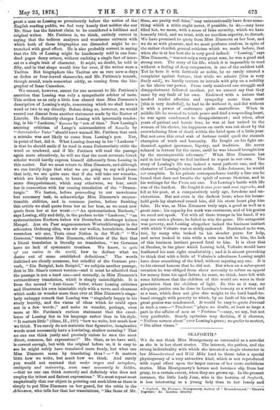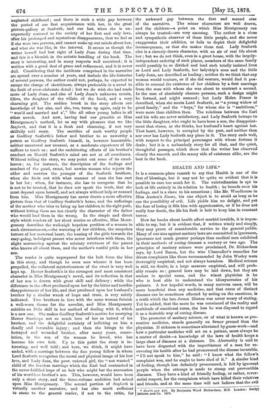SEAFORTIL*
WE do not think Miss Montgomery so successful as a novelist as she is in her short stories. The interest, the pathos, and the strong individuality with which she invested a single character in her Misunderstood and Wild Mike lend to those tales a special physiognomy of a very attractive kind, which is not reproduced with equal effect upon the larger canvas of her more ambitions stories. Miss Montgomery's heroes and heroines slip from her grasp, to a certain extent, when they are grown up. In the present instance, the little Lady Joan, who is the heroine of Seaforth, is less interesting as a young lady than in her lonely and • Seaforth. By Florence Montgomery, Author of " Misunderstood," " Thrown Together; Sc. London: Bentley. neglected childhood ; and there is such a wide gap between the period of our first acquaintance with her, in the great picture-gallery at Seaforth, and our last, when she is un- expectedly restored to the society of her first and only love, after his prolonged and mysterious disappearance, that we feel as if she were two persons, and cannot make up our minds about her, and what she was like, in the interval. It seems as though the writer herself had lost sight of Lady Joan during that time, and this is a blemish in the artistic handling of the book. The story is interesting, and in many respects well contrived ; it is written with a good deal of grace and refinement, and it is never dull. Considering that the incidents comprised in the narrative are spread over a number of years, and include the life-histories of several persons, the author could not, perhaps, be expected to escape the charge of sketchiness, always preferable in a novel to the fault of over-elaborate detail ; but we do wish she had made more of Lady Joan, and also of Lady Joan's unknown cousin, Olive, the daughter of the villain of the book, and a very charming girl. The sudden break in the story affects our knowledge of her also, and she,,too, turns up again, only to be " woo'd and married and a'," like all other young ladies in all other novels. And now, having had our grumble at Miss Montgomery's method, let us say with pleasure that we like Seaforth, and that it is a fresh and charming, if not very skilfully told story. The sacrifice of such worthy people as Godfrey Seaforth's father and brother to so unworthy a person as Godfrey Seaforth himself, is, however lamentable, neither unnatural nor unusual, as a moderate experience of life suffices to teach us ; and the embittering effects of his brother's conduct on Harold Seaforth's mind are not at all overdrawn. Without telling the story, we may point out some of its excel- lences ; as, for instance, the description of the feelings and conduct of the good, sweet, but unwise woman who rejects the older and marries the younger of the Seaforth brothers, when she finds out with what manner of man she has cast in her lot ; when, for instance, she has to recognise that he is not to be trusted, that he does not speak the truth, that she must depend upon herself, and act always without help or counsel from him. Miss Montgomery has never drawn a more effective picture than that of Godfrey Seaforth's home, and the sufferings of the mother who tries to bring up her children in the right path, without letting them see too clearly the character of the father who would lead them in the wrong. In the simple and direct style which renders all her short stories so effective, Miss Mont- gomery describes the well-nigh hopeless position of a woman in such circumstances,—the wavering of her children, the unspoken terrors of her maternal heart, the leaning of the girls towards the easy-going, indulgent parent who never interferes with them, the slight murmuring against the salutary strictness of the parent who knows all about them, and the mother's restful pride in her
MOM
The reader is quite unprepared for the bolt from the blue in this story, and though he soon sees whence it has been propelled, the collateral mysteriousness of the event is very well kept up. Hester Seaforth's is the strongest and most consistent character in Miss Montgomery's novel, and its reflection in that of her son is drawn with great skill and delicacy ; while the difference in the effect produced upon her by the bitter and terrible disappointment of her life, and that produced upon her husband's brother by a similar wreck of hope and trust, is very subtly indicated. Two brothers in love with the same woman furnish a well-worn theme for the novelist, and Miss Montgomery exhibits no little skill in her method of dealing with it, which is a new one. She makes Godfrey Seaforth's motive for marrying Hester Stanhope not so much love of her as hatred of his brother, and the delightful certainty of inflicting on him a deadly and incurable injury ; and then she brings to the betrayed and wounded brother, after many years, conso- lation, in the son of the woman he loved, who has become his own heir. Up to this point the story is in- teresting, and well told ; and here, we think, it might have ended, with a marriage between the fine young fellow in whom Lord Seaforth recognises the moral and physical image of his lost love, and Lady Joan, the poor, unloved girl, the " not wanted " child of the loveless marriage which the Earl had contracted in the never-fulfilled hope of an heir who might bar the succession of his worthless brother's son. This, however, would have been only a short story, and the three-volume ambition had seized upon Miss Montgomery. The second portion of Seaforth is virtually another narrative, and has also merit sufficient to atone to the general reader, if not to the critic, for
the awkward gap between the first and second eras of the narrative. The minor characters are well drawn, and the children—a point on which Miss Montgomery can always be trusted—are very amusing. The author is a close and sympathetic observer of these little people, and she never exaggerates their oddities, or fails to depict their delightful inconsequence, so that she makes them real. Lady Seaforth also is a cleverly-drawn character, with an air of real life about her ; but we do not think, even in a great house, with the largely- independent ordering of such places, members of the same family could possibly be so divided and lead such totally isolated lives as Lord and Lady Seaforth, her ladyship's sons and the little Lady Joan, are described as leading ; neither do we think that any woman would venture, or if she did venture, would find it pos- sible to conceal the existence of her children by a first marriage from the man with whom she was about to contract a second. In the case of absolutely obscure persons, such a design might be formed, and might succeed ; but Lady Helen Fraser is described, when she meets Lord Seaforth, as "a young widow of good family," and the " boys," for whom she is " ambitious,' were more than children then. The relations between the Earl and his wife are never satisfactory, and Lady Seaforth betrays to the little daughter, who ought to have been a son, the disappoint- ment that closes, as she thinks, her husband's heart against her. That heart, however, is occupied by the past, and neither then nor ever has Lady Seaforth any place in it. The story ends well, with respect to the principal personages with whose fortune it deals ; but it is a melancholy story for all that, and the quiet, thoughtful passages, which show that the writer has observed closely the smooth and the seamy side of existence alike, are the best in the book.



































 Previous page
Previous page